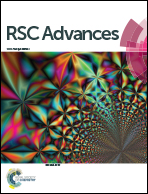Ultra-small Au nanoparticles stabilized by silica hollow nanospheres for styrene oxidation with oxygen
Abstract
Ultra-small Au nanoparticles (<2 nm) supported on hollow silica nanospheres were successfully fabricated with the aid of chemical modification (–SH groups) or through simple immersion method, leading to supported catalysts Au/SH-HNS and Au/HNS. The resulting solid catalysts showed good thermal stability and the small particle sizes could be remained even at high temperature of 350 °C. Such catalysts were catalytically active in the oxidation of styrene using O2 as oxidant under 1 atm pressure. The catalytic results showed that the activity strongly depends on the Au loading amount, and the loading of 4–5 wt% led to the highest activity. Significant rate enhancement was observed with gold nanoparticles supported on pure silica in comparison with thiol modified silica nanospheres, suggesting the negative effects of thiol groups. The solid catalyst could be reused at least 8 reaction cycles without significant decrease in activity and selectivity. This study not only supplies an active, recoverable catalyst for the green transformation of styrene, but also demonstrates that the hollow silica nanosphere material has a superior ability in stabilizing metal nanoparticles against growth.


 Please wait while we load your content...
Please wait while we load your content...